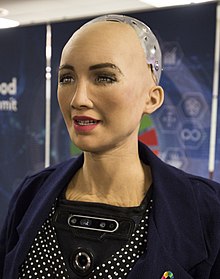This article needs to be updated. (January 2023) |

Affective computing is the study and development of systems and devices that can recognize, interpret, process, and simulate human affects. It is an interdisciplinary field spanning computer science, psychology, and cognitive science.[1] While some core ideas in the field may be traced as far back as to early philosophical inquiries into emotion,[2] the more modern branch of computer science originated with Rosalind Picard's 1995 paper[3] on affective computing and her book Affective Computing[4] published by MIT Press.[5][6] One of the motivations for the research is the ability to give machines emotional intelligence, including to simulate empathy. The machine should interpret the emotional state of humans and adapt its behavior to them, giving an appropriate response to those emotions.
- ^ Tao, Jianhua; Tieniu Tan (2005). "Affective Computing: A Review". Affective Computing and Intelligent Interaction. Vol. LNCS 3784. Springer. pp. 981–995. doi:10.1007/11573548.
- ^ James, William (1884). "What Is Emotion". Mind. 9 (34): 188–205. doi:10.1093/mind/os-IX.34.188. Cited by Tao and Tan.
- ^ "Affective Computing" MIT Technical Report #321 (Abstract), 1995
- ^ Picard, Rosalind (1997). Affective Computing. Cambridge, MA: MIT Press. p. 1.
- ^
Kleine-Cosack, Christian (October 2006). "Recognition and Simulation of Emotions" (PDF). Archived from the original (PDF) on May 28, 2008. Retrieved May 13, 2008.
The introduction of emotion to computer science was done by Pickard (sic) who created the field of affective computing.
- ^
Diamond, David (December 2003). "The Love Machine; Building computers that care". Wired. Archived from the original on 18 May 2008. Retrieved May 13, 2008.
Rosalind Picard, a genial MIT professor, is the field's godmother; her 1997 book, Affective Computing, triggered an explosion of interest in the emotional side of computers and their users.